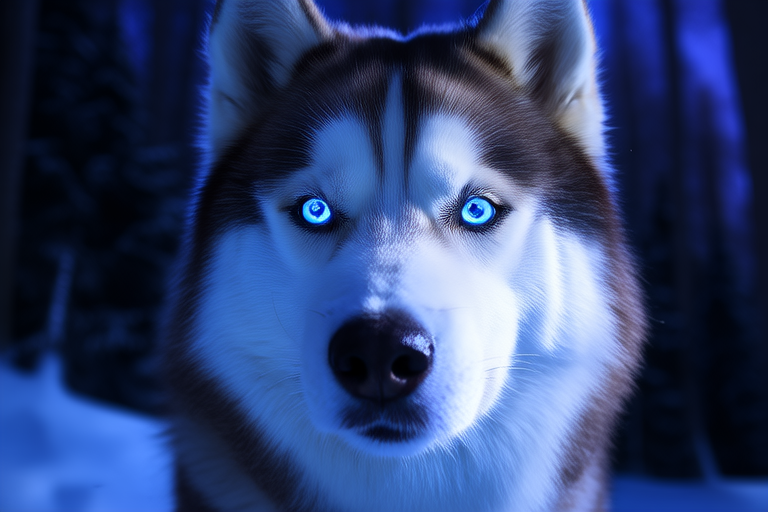The Enigmatic Siberian Husky: A Journey Through Eyes and Spirit
The Siberian Husky is a breed that has captured the hearts of many with its striking appearance, particularly its captivating blue eyes. These dogs have a rich history intertwined with their physical traits, which have made them popular not only as working dogs but also as beloved pets. This article explores the unique characteristics of Siberian Huskies, focusing especially on their mesmerizing blue eyes, the genetic factors behind their eye color, its variations, and how it relates to their temperament and breed origins. Additionally, we will discuss their role in sled racing and companionship, providing insights into their spirited nature and offering tips for potential owners.
Origins and History
Siberian Huskies originated from the Chukchi people of northeastern Asia. These indigenous tribes relied on the dogs for transportation across vast snowy terrains, where they were used to pull sleds and herd reindeer. The Siberian Husky was bred specifically for endurance, speed, and strength, making them ideal for long-distance sledding. Their ability to withstand harsh weather conditions and their friendly demeanor towards humans and other animals made them invaluable to the Chukchi.
In the early 20th century, Siberian Huskies gained international recognition when they participated in the All-Alaskan Sweepstakes, a famous sled-dog race. One notable event occurred during the 1925 diphtheria outbreak in Nome, Alaska, where a relay of mushers and their Siberian Huskies delivered life-saving antitoxin across hundreds of miles of frozen terrain. This heroic feat cemented the breed’s reputation as both hardworking and loyal.
The Mysterious Blue Eyes
One of the most striking features of Siberian Huskies is their piercing blue eyes, which can range from icy blue to a more vibrant shade. However, not all Siberian Huskies have blue eyes; they can also have brown, green, or even heterochromic (two different colored) eyes. The genetic basis for this eye color variation lies in a gene called ALX4, which influences the development of the iris. The presence of certain alleles can result in blue eyes, while others lead to brown or green.
The blue eye color in Siberian Huskies is often associated with their spirited and independent nature. While this connection is more symbolic than scientific, it adds to the mystique surrounding the breed. Owners often describe their Siberian Huskies as having a “mysterious gaze” that reflects their adventurous spirit. This characteristic has made the breed popular in various media, from films to advertisements.
Temperament and Social Behavior
Siberian Huskies are known for their friendly and outgoing personalities. They tend to get along well with children and other pets, making them excellent family dogs. However, their strong prey drive means they may chase smaller animals like cats or rabbits. Early socialization and training are essential to ensure they grow up to be well-behaved companions.
Despite their friendly nature, Siberian Huskies can be independent and stubborn. This trait stems from their history as working dogs, where they needed to make quick decisions in challenging environments. Owners must be patient and consistent when training these intelligent dogs, using positive reinforcement techniques to encourage good behavior.
Exercise Needs and Intelligence
Given their heritage as working dogs, Siberian Huskies have high energy levels and require plenty of physical activity. They thrive in environments where they can run freely and participate in activities such as hiking, running, or playing fetch. Without adequate exercise, they may become bored and destructive. Therefore, potential owners should be prepared to dedicate time each day to keeping their Siberian Husky active.
Intelligence plays a significant role in the Siberian Husky’s behavior. They are quick learners but can also be selective about following commands. Owners need to establish themselves as leaders and provide clear guidance to ensure the dog understands what is expected of them. Interactive toys and puzzles can help stimulate their minds and prevent boredom.
Tips for Potential Owners
If you’re considering adopting a Siberian Husky, there are several important factors to keep in mind:
- Exercise Requirements: Siberian Huskies need at least an hour of vigorous exercise daily. This could include walking, running, or engaging in outdoor activities.
- Training: Consistent training using positive reinforcement methods is crucial for shaping their behavior. Patience and consistency are key, given their independent nature.
- Grooming: Regular brushing is necessary to manage their thick coat, especially during shedding seasons. Bathing should be done sparingly to avoid stripping natural oils from their skin.
- Healthcare: Regular veterinary check-ups and vaccinations are essential. Some common health issues in the breed include hip dysplasia, progressive retinal atrophy, and seizures.
- Companionship: Siberian Huskies are pack animals and enjoy being around people. They should not be left alone for extended periods, as this can lead to separation anxiety and destructive behavior.
Conclusion
The Siberian Husky is a breed with a fascinating history and unique characteristics that have made it a favorite among dog lovers worldwide. From their captivating blue eyes to their spirited nature, these dogs offer a blend of beauty, intelligence, and companionship. Whether you’re an experienced dog owner or new to the world of pet care, a Siberian Husky can bring joy and adventure into your life. By understanding their needs and providing proper care, you can ensure that your Siberian Husky remains healthy, happy, and full of spirit.
